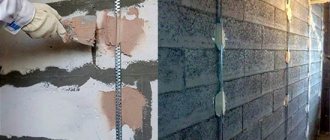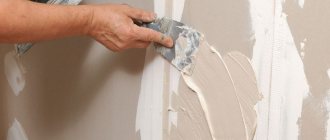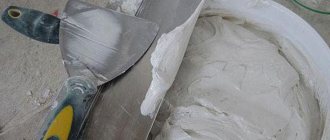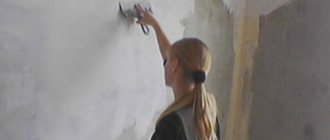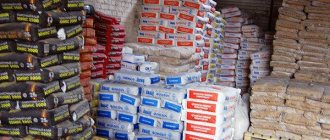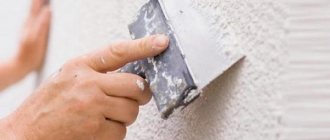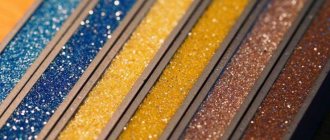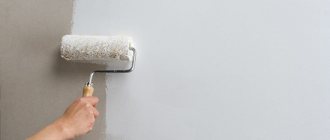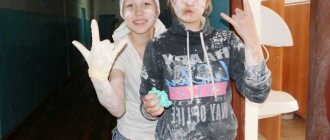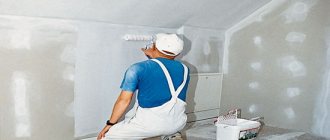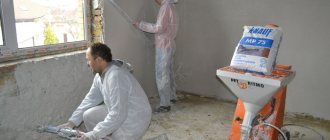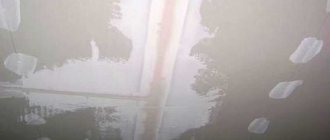Is it necessary to putty after machine plastering?
Before deciding to apply an additional layer of putty, evaluate the quality of the machine-made plaster. To do this you will need a level and... your palm. Using a level, you can determine whether there are gaps or unevenness in the plastered surface. Then run your palm over the layer of plaster: it should be smooth as glass. If you feel any roughness or snags, you will have to resort to applying a layer of putty.
An additional layer of finishing putty will allow you to:
- prevent peeling of the finishing plaster;
- increase the adhesion (tenacity) of surfaces with finishing materials (paint, varnish, wallpaper), they will not peel off;
- reduce consumption of assembly adhesive and paints and varnishes.
Whether or not to putty surfaces is a personal matter. And yet, experts say that an extra layer of putty will not harm.
Applying plaster by machine: features
First of all, it should be noted that for the machine method, special gypsum mixtures are used - plasters for machine application. Using a plastering unit allows you to get a positive result thanks to:
- High blood pressure. The mixture is exposed to high pressure, which has a positive effect on the quality of adhesion of the plaster to the wall surface.
- Uniformity. Using two screws, the mixture is ground to a homogeneous composition. This texture ensures the strength of the plaster and prevents cracks from occurring on the treated surface.
- Accuracy. The unit is equipped with built-in software that controls the consistency of the solution and the proportions of the components. This way the machine never makes mistakes.
The use of plastering machines allows you to:
- Avoid heavy physical labor and achieve better quality cladding than when doing the work manually.
- Despite the fact that the layer of material dries for about 7 days, the time required for surface finishing is reduced by 4-5 times.
- Reduce material consumption and thereby reduce the cost of purchasing mixtures.
- The cost of work per m² is two times lower compared to manual plastering.
Compared to manual plastering, using a machine allows you to obtain an almost perfectly flat surface.
Choosing putty for walls after plastering
While the primer dries, you need to choose what to putty on the walls after plastering, since they need to be leveled before further finishing. For this purpose, it is better to purchase a starting mixture: it is designed specifically for treating walls after plastering, and is suitable for eliminating significant differences in height.
Also, when the primer dries after plastering the walls, you can treat their surface with universal or finishing putty. The latter, in comparison with the starting mixture, have comparatively worse consumer characteristics, and are usually used in cases where the plaster layer does not have significant flaws.
Based on the material, putty bases are divided into three categories:
- cement - resistant to moisture, but have a high degree of shrinkage;
- gypsum - cheap, does not shrink, is pliable when applied, but is sensitive to humidity levels;
- polymer ones are expensive, do not shrink, and are resistant to moisture.
Most often, gypsum-based putties are used; however, their scope of use is limited; they are not recommended for use in very wet areas where there is contact with water in the bathroom or swimming pool. Otherwise, why putty the walls after plastering if, due to high humidity, the gypsum-based coating will quickly become unusable.
It is strictly forbidden to use gypsum plasters outdoors since moisture and frost destroy the Rodband mixture and other similar ones.
According to the sales form, putties are presented in two categories:
- ready-made - an already diluted solution that can be used immediately after opening the container;
- dry - mixtures intended for self-preparation, but having a much lower cost than ready-made mixtures.
Thus, the cheapest option is dry gypsum powder, but it also has the lowest quality. Gypsum mixtures are excellent for sealing cracks in walls. The most expensive are ready-made polymer-based putties; these materials are best used for making the finishing layer.
Technology for processing plastered walls
Often, before starting putty work, the question arises as to whether the beacons need to be pulled out after plastering, or whether they can be left in the walls. It is recommended to do this without fail. How to putty plastered walls under wallpaper? The beacons are made from metal, and if left, they will corrode over time.
This, in turn, will reduce the strength of the plaster layer, and ultimately lead to its crumbling. Cracks and other damage will appear on the surface of the walls.
After the decision has been made whether it is necessary to choose beacons after plastering, you can begin to putty the surface. The bottom, coarsest layer of material is applied. Using mixtures for starting putty, holes and grooves are filled in and large differences in height are eliminated.
How to putty plastered walls with your own hands? The thickness of one starting layer can sometimes reach 15-20 mm.
You can put a painting mesh under the putty layer, stretching it over the entire surface of the wall being treated. This will make it possible to achieve a more even laying of the material and improve the strength of the starting layer of putty.
When the starting coating has dried, the finishing process begins, which is carried out using finishing mixtures. Unlike the starting one, it is applied in a very thin layer so that it completely repeats the resulting wall relief. In some cases, the question arises whether it is necessary to putty the walls after plastering with Rotband in order for the surface to be perfectly flat.
If you follow the technology, there is no need to apply additional finishing layers, the walls will already be level.
Preparing walls for painting or wallpapering
After completing the putty work, you should wait until the walls are completely dry, and only then prepare them for painting or wallpapering. The technology for performing both types of finishing is the same; the difference lies only in the nuances when choosing finishing materials. You can spend as much time choosing the appropriate finishing method as it takes for the walls to dry after plastering - about a month.
So, after the primer has dried, the walls are primed for painting using a special primer, sometimes after preliminary sanding. If you plan to apply wallpaper, then, instead of a primer, the walls can be coated with wallpaper glue after drying. In this case, more water is added to it than usual.
In addition, the adhesive must be recommended by the manufacturer for use in this capacity, otherwise it is better to apply a standard priming mixture to the walls.
Is it possible to putty with gypsum plaster? Methods of applying solutions
The intended purposes of plaster and putty are based on the thickness of the layers with which these mixtures are applied. And the method of applying it depends on the thickness of the layer. Plaster can be used to level out level differences of up to 10 cm, and even more with reinforcement and fastening of reinforcement to the base. You can prepare the plaster solution yourself (cement-sand) or purchase a ready-made dry mixture, which only requires mixing with water for use.
The homemade DSP solution is applied to the base with a trowel or mechanically, after which it is manually leveled along the beacons and rubbed.
The process, which requires professional skills, is labor-intensive and messy. The coating requires daily moistening in the first week; full strength gains occur within 28 days.
Plaster mortars from ready-made mixtures are placed on the walls with spatulas, after which they are leveled according to the beacons using the same rules. The process is slightly less messy than when working with DSP. Maintenance of the coating is carried out in accordance with the instructions for use; the period of strength development depends on the binder material - cement, gypsum or gypsum cement.
The thickness of the layer of putty to be laid depends on whether the mixture is a starting or finishing leveling material - in the compositions of the first group, filler of larger fractions is used.
Using starting putties, depending on the individual characteristics of the solution, differences of up to 2 cm are leveled - by applying one-time layers no more than 5 mm thick with layer-by-layer reinforcement. The coating of the finishing putty mixture should be no thicker than 1-2 mm. Putty mixtures are applied to the walls manually using spatulas of various widths.
Caring for the coating involves avoiding drafts; the drying time for each layer is 1-2 days. Dried putty is most often sanded using an abrasive method, which is accompanied by significant dust formation.
